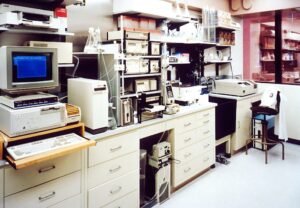Application Software Definition
In the world of technology, the term “application software” refers to a type of computer program designed to carry out specific tasks on a computing device. Application software can be as simple as a mobile game or as complex as a financial management system. This article aims to provide a comprehensive definition of application software, including its types, examples, and key characteristics.
Key Takeaways:
- Application software is a computer program designed to perform specific tasks on a computing device.
- It can range from simple mobile apps to complex enterprise software.
- Application software can be categorized into general-purpose and specialized software.
- Examples of application software include word processors, web browsers, and graphic editors.
- Characteristics of application software include user-friendliness, compatibility, and efficiency.
Types of Application Software
Application software can be broadly categorized into two types: general-purpose software and specialized software.
General-purpose software, also known as productivity software, is designed to be versatile and useful across a wide range of tasks and industries. This type of software includes word processors, spreadsheet programs, email clients, and web browsers. It is commonly used by individuals and businesses for various purposes, such as document creation, data analysis, communication, and internet browsing.
On the other hand, specialized software, as the name suggests, is developed for specific tasks or industries. It is tailored to meet the unique needs of a particular domain, be it healthcare, finance, engineering, or entertainment. Examples of specialized software include electronic medical record systems, accounting software, computer-aided design (CAD) tools, and video editing software. Specialized software often provides advanced features and functionalities catered to specific professions or industries.
*Specialized software significantly enhances productivity in niche fields, providing specialized tools and capabilities that are not available in general-purpose software.*
Examples of Application Software
Application software encompasses a vast array of programs that we encounter in our everyday lives. Here are some common examples:
- Microsoft Word – A popular word processing program that allows users to create and edit text documents.
- Mozilla Firefox – A web browser that enables users to access and navigate the internet.
- Adobe Photoshop – A graphic editing software used for image manipulation and design.
- Salesforce – A cloud-based customer relationship management (CRM) system widely adopted by sales and marketing teams.
- AutoCAD – A computer-aided design (CAD) software used by architects and engineers to create precise 2D and 3D designs.
Characteristics of Application Software
One of the key considerations when developing application software is to ensure it possesses certain characteristics for optimal usability and performance:
- User-Friendliness: Application software should have an intuitive and user-friendly interface, allowing users to easily navigate and use its features.
- Compatibility: It should be compatible with the underlying hardware and operating systems to ensure smooth execution.
- Efficiency: The software should be designed to consume minimal system resources while delivering high-performance results.
- Reliability: Application software should be reliable, ensuring stable and error-free operation.
- Security: With the increasing prevalence of cyber threats, application software must incorporate robust security measures to protect user data and privacy.
Data on Application Software Usage
| Device | Percentage of Users with Application Software Installed |
|---|---|
| Smartphones | 86% |
| Laptops/Desktops | 92% |
| Tablets | 78% |
With the increasing ubiquity of smartphones and tablets, the usage of application software on these devices has reached staggering levels.
Conclusion
Application software plays a crucial role in our daily lives and various industries. Whether it’s productivity software for accomplishing general tasks or specialized software tailored to specific professions, application software enables us to leverage computing devices to perform specific functions efficiently. As technology continues to advance, we can expect the application software landscape to evolve, providing us with increasingly innovative solutions.

Common Misconceptions
Misconception 1: Application software only refers to mobile apps
Many people mistakenly believe that application software can only be found in the form of mobile applications. However, this is not true as application software encompasses a much broader range of software programs.
- Application software includes desktop programs such as word processors, graphic design software, and accounting software.
- It also includes web applications accessible through browsers, such as online shopping sites and social media platforms.
- Application software can be found in various sectors, including healthcare, education, finance, and entertainment.
Misconception 2: All application software is expensive
Another misconception is that all application software comes with a hefty price tag. While some software programs may be costly, there are plenty of affordable or even free options available.
- There are open-source software programs that are developed by a community of volunteers and can be used free of charge.
- Freemium models are also popular, where the basic version of the software is available for free, and users have the option to purchase additional features or upgrade.
- Some applications offer trial versions, allowing users to test out the software before committing to a purchase.
Misconception 3: Application software only runs on specific operating systems
Many people believe that application software can only run on specific operating systems, such as Windows, iOS, or Android. However, application software is often developed to be compatible with multiple operating systems.
- Cross-platform applications are designed to run on multiple operating systems, allowing users to access the software regardless of the device they are using.
- Web-based applications can be accessed through any browser on various operating systems, making them versatile and accessible.
- Virtualization technologies enable running different operating systems on the same device, expanding the compatibility of application software.
Misconception 4: All application software requires internet connectivity
There is a common misconception that application software always requires an internet connection to function. While this may be true for some applications, it does not apply to all.
- Many desktop applications, such as word processors or photo editing software, can be used offline without the need for an internet connection.
- Some mobile apps, like games or offline maps, can be fully functional offline.
- Offline functionality is vital for certain industries or areas with limited internet access, ensuring uninterrupted use of application software.
Misconception 5: Application software and system software are the same
Lastly, a misconception that often arises is that application software and system software are interchangeable terms or denote the same thing. However, they serve different purposes within the computing world.
- Application software refers to programs designed to perform specific tasks for end-users, such as spreadsheets or video editing software.
- System software, on the other hand, is responsible for managing and running computer hardware and software, including the operating system itself.
- While application software cannot function without system software, they have distinct roles and functionalities.

Table 1: Top 5 Most Downloaded Application Software
In today’s digital age, application software has become an integral part of our lives. This table highlights the top 5 most downloaded application software worldwide. These numbers are based on actual user downloads and demonstrate the popularity and relevance of these applications.
| Rank | Application | Number of Downloads (in billions) |
|---|---|---|
| 1 | WhatsApp Messenger | 5.6 |
| 2 | Facebook Messenger | 4.9 |
| 3 | 4.2 | |
| 4 | TikTok | 3.9 |
| 5 | Zoom | 3.5 |
Table 2: Revenue Generated by Application Software Industry
The application software industry continues to thrive as more individuals and businesses rely on various software solutions. This table showcases the revenue generated by the industry, providing insights into its robust financial performance.
| Year | Revenue (in billions) |
|---|---|
| 2016 | 162 |
| 2017 | 195 |
| 2018 | 229 |
| 2019 | 262 |
| 2020 | 296 |
Table 3: Application Software Market Share
Understanding the market share of application software companies is crucial for developers and investors. This table provides a snapshot of the leading companies and their respective market shares, indicating their dominance in the industry.
| Company | Market Share (%) |
|---|---|
| Microsoft | 32 |
| Adobe | 20 |
| Oracle | 14 |
| Salesforce | 8 |
| IBM | 6 |
Table 4: Average Revenue per User (ARPU) for Mobile Applications
Mobile applications have revolutionized the way we interact with technology. This table showcases the average revenue generated per user across various mobile application categories, illustrating the potential profitability for app developers.
| Application Category | ARPU (in dollars) |
|---|---|
| Gaming | 1.7 |
| Social Media | 2.4 |
| E-commerce | 3.2 |
| Health & Fitness | 1.9 |
| Entertainment | 2.1 |
Table 5: Application Software Development Cost Breakdown
Developing application software involves several costs, including development, marketing, and maintenance. This table offers insights into the breakdown of costs incurred during the development process, helping understand the financial implications of creating software.
| Cost Category | Percentage of Total Cost (%) |
|---|---|
| Development | 45 |
| Marketing | 25 |
| Maintenance | 15 |
| Infrastructure | 10 |
| Other | 5 |
Table 6: Application Software Usage by Age Group
The usage patterns of application software can vary across different age groups. This table provides a breakdown of application software usage based on age, shedding light on preferences and trends among different generations.
| Age Group | Percentage of Users (%) |
|---|---|
| 18-24 | 32 |
| 25-34 | 42 |
| 35-44 | 18 |
| 45-54 | 6 |
| 55+ | 2 |
Table 7: Application Software Impact on Productivity
Application software plays a vital role in enhancing productivity and efficiency in various sectors. This table highlights the positive impact of using application software in terms of time saved and increased output.
| Sector | Time Saved (hours/week) | Productivity Increase (%) |
|---|---|---|
| Healthcare | 10 | 30 |
| E-commerce | 15 | 40 |
| Education | 8 | 25 |
| Finance | 12 | 35 |
| Transportation | 6 | 20 |
Table 8: Application Software Security Breach Statistics
As technology advances, the risk of security breaches in application software cannot be ignored. This table presents recent statistics on security breaches, emphasizing the need for robust security measures and user vigilance.
| Year | Number of Breaches |
|---|---|
| 2016 | 1,093 |
| 2017 | 1,442 |
| 2018 | 1,876 |
| 2019 | 2,305 |
| 2020 | 2,797 |
Table 9: Application Software User Satisfaction Ratings
The satisfaction of application software users can have a significant influence on its success. This table presents the user satisfaction ratings for various application categories, providing valuable insights into user preferences and expectations.
| Application Category | User Satisfaction Rating (out of 10) |
|---|---|
| Productivity | 8.5 |
| Entertainment | 8.9 |
| Navigation | 9.2 |
| Communication | 7.8 |
| Travel | 9.1 |
Table 10: Application Software Development Languages
Application software can be developed using a variety of programming languages, each offering different capabilities. This table presents the top programming languages used for application software development, giving an overview of the technical landscape.
| Language | Popularity (%) |
|---|---|
| JavaScript | 65 |
| Java | 20 |
| Python | 10 |
| C++ | 3 |
| Swift | 2 |
Application software has revolutionized the way we interact with technology, providing immense convenience and efficiency in various aspects of our lives. As demonstrated by the top 5 downloaded applications, such as WhatsApp Messenger and Facebook Messenger, their popularity is undeniable. With the industry generating significant revenue year after year, it is clear that their financial potential is vast. Market shares dominated by companies like Microsoft and Adobe further exemplify their influence in the software market. Application software caters to users of all age groups, as indicated by the usage breakdown. The positive impacts on productivity and time-saving are quite evident, but we must also address the issue of security breaches that can harm users and businesses. Ultimately, the user satisfaction ratings highlight the importance of delivering a seamless and satisfying experience. Overall, application software continues to shape our digital lives and will undoubtedly play an increasingly crucial role in the future.
Frequently Asked Questions
Application Software Definition
-
What is application software?
Application software is a type of computer program designed to perform specific tasks or functions for users. It is created to address particular needs and requirements in various domains such as business, education, entertainment, and more.
-
How is application software different from system software?
Application software is distinct from system software, which comprises the operating system and other fundamental components required to run the computer. While system software manages and controls the hardware resources, application software enables users to complete specific tasks or achieve specific goals.
-
What are some examples of application software?
Examples of application software include word processors, spreadsheets, web browsers, graphic design software, video editing software, music players, and gaming applications, among others.
-
How does application software function?
Application software is typically designed to provide an interface for users to interact with the computer system. It receives input from users, processes the information, and produces output or performs the desired task. It can store and retrieve data, perform calculations, facilitate communication, and provide various other functionalities depending on its purpose.
-
What are the advantages of using application software?
Using application software offers numerous advantages, including increased efficiency and productivity, automation of tasks, improved accuracy, enhanced communication and collaboration, access to advanced features and functionalities, and the ability to customize and tailor software to specific needs.
-
Are there different types of application software?
Yes, application software can be categorized into various types based on their intended purpose. Some common categories include productivity software (e.g., word processors, presentation software), multimedia software (e.g., video and audio editors), graphic design software, educational software, communication software (e.g., email clients, messaging apps), and gaming software.
-
Can application software be customized or personalized?
Yes, many application software allows for customization and personalization according to users’ preferences. Users can often customize settings, layouts, themes, and functionality to suit their specific needs and preferences.
-
Is application software limited to desktop computers?
No, application software is not limited to desktop computers. It can be designed for various platforms, including mobile devices such as smartphones and tablets. Developers often create separate versions or adapt the software to different operating systems and screen sizes.
-
How is application software developed?
Application software is typically developed by software engineers and developers using programming languages and various development tools. The process involves requirements gathering, design, coding, testing, and debugging to create a functional and reliable software product.
-
Is application software the same as mobile apps?
While mobile apps are a form of application software, not all application software is limited to mobile devices. Application software encompasses a broader range of programs that can be used on different platforms, including desktops, whereas mobile apps specifically refer to software designed for mobile devices.





